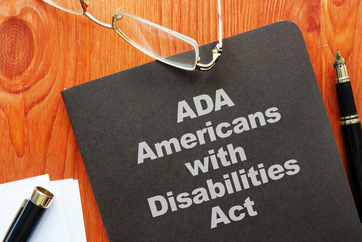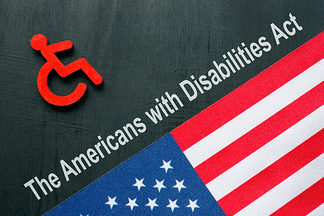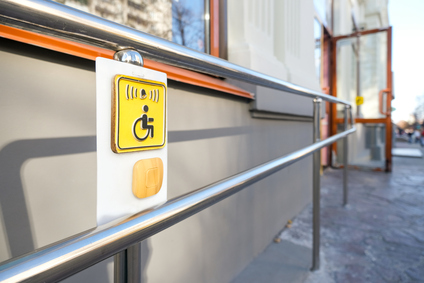
What is ADA?
The Americans with Disabilities Act (ADA) is a landmark civil rights law that ensures accessibility and prohibits discrimination against individuals with disabilities. The primary goal of the ADA is to provide equal opportunities and accessibility in all areas of public life, including jobs, schools, transportation, and all public and private places open to the general public.
By mandating accessibility, the ADA aims to remove barriers that prevent individuals with disabilities from participating fully in society. This includes ensuring that physical spaces, digital environments, and services are accessible to everyone. Whether it's installing ramps and elevators in buildings, providing accessible formats for digital content, or offering services such as sign language interpreters, the ADA sets the standards to promote inclusion and accessibility.

The importance of the ADA cannot be overstated. It not only protects the rights of individuals with disabilities but also enhances their ability to live independently and engage with the community.
For businesses and organizations, complying with the ADA is not just a legal obligation but a commitment to creating an inclusive and accessibly environment for all customers, employees, and visitors.
History and Background
The ADA was signed into law on July 26, 1990, by President George H.W. Bush, marking a significant milestone in the civil rights movement for individuals with disabilities. The ADA was inspired by earlier laws such as the Rehabilitation Act of 1973, which prohibited discrimination based on disability in federal programs and services.
The ADA emerged in response to the growing awareness and activism of the disability rights movement throughout the 1970s and 1980s. Advocates for disability rights highlighted the pervasive discrimination and accessibility barriers that people with disabilities faced daily. Their efforts led to a bipartisan initiative in Congress to draft and pass comprehensive legislation addressing these issues.

Since its enactment, the ADA has undergone amendments to strengthen its protections and clarify its provisions. A notable amendment is the ADA Amendments Act (ADAAA) of 2008, which broadened the definition of disability, making it easier for individuals to receive protection under the law.
Scope of the ADA
The ADA is divided into several titles, each focusing on different areas of public life to promote accessibility and equal opportunities.
Title I: Employment
Title I focuses on ensuring equal employment opportunities for individuals with disabilities.

Providing Reasonable Accommodations
Employers are required to provide reasonable accommodations to qualified employees or job applicants with disabilities.
These accommodations can include modifications to workspaces, flexible work schedules, and assistive technologies, ensuring that individuals with disabilities can perform their job duties effectively.
Examples
Employers may need to install wheelchair ramps, provide accessible parking, or adjust workstations to accommodate individuals with disabilities. Additionally, they may need to provide specialized equipment or modify job duties to accommodate specific needs.
Protections Against Discrimination
Title I prohibits discrimination in all aspects of employment, including hiring, firing, advancement, compensation, and training. Employers cannot discriminate against individuals with disabilities in any aspect of the employment process and must provide equal opportunities for all employees.
This ensures that individuals with disabilities have the same rights and opportunities in the workplace as their non-disabled peers.
Title II: Public Services
Title II ensures that state and local government entities provide equal access to their programs, services, and activities for individuals with disabilities.

Ensuring Accessible Public Services
State and local government entities must make their programs, services, and activities accessible to individuals with disabilities. This includes making reasonable modifications to policies, practices, and procedures to accommodate the needs of individuals with disabilities.
Examples
This can include installing wheelchair ramps, providing accessible public transportation, ensuring that public buildings have accessible entrances and restrooms, and offering sign language interpreters for public events.
Protections Against Discrimination
Title II prohibits discrimination by state and local government entities, ensuring that individuals with disabilities have equal access to government services, programs, and activities.
This ensures that individuals with disabilities can fully participate in civic life and exercise their rights as citizens.
Title III: Public Accommodations
Title III ensures that private businesses and nonprofit organizations serving the public are accessible to individuals with disabilities.

Ensuring Accessibility Public Accommodations
Businesses are required to remove architectural barriers in existing buildings where feasible and ensure that new constructions and alterations are accessible.
This ensures that individuals with disabilities can navigate public spaces with ease.
Examples
In practice, this means installing ramps, providing accessible restrooms, ensuring seating in theaters is wheelchair-accessible, and offering braille menus in restaurants.
Protections Against Discrimination
Title III prohibits discrimination in public accommodations, ensuring that individuals with disabilities have the same access to goods, services, facilities, privileges, advantages, and accommodations as everyone else.
Title IV: Telecommunications
Title IV of the Americans with Disabilities Act (ADA) addresses accessibility in telecommunications services for individuals with disabilities.

Ensuring Accessible Telecommunications
Title IV requires telephone and internet companies to provide accessible telecommunications services for individuals with hearing and speech disabilities.
This includes providing relay services that allow individuals with hearing or speech impairments to communicate over the phone.
Examples
Telephone companies must provide services such as text telephones (TTY), video relay services (VRS), and captioned telephone services to ensure effective communication for individuals with hearing or speech disabilities.
Additionally, internet companies must ensure that their websites and online services are accessible to individuals with disabilities.
Protections Against Discrimination
Title IV prohibits discrimination in telecommunications services based on disability, ensuring that individuals with disabilities have equal access to communication services.
This ensures that individuals with disabilities can communicate effectively and access information and services on par with others.
Title V: Miscellaneous Provisions
Title V contains various provisions that apply across all other titles of the ADA.

Ensuring Compliance and Enforcement
It provides a framework for ensuring that businesses and organizations understand their obligations under the ADA and are held accountable for violations.
Examples
This includes protections against retaliation and coercion for individuals exercising their rights under the ADA, guidelines for the construction and design of accessible facilities, and clarifications on how the ADA interacts with other federal and state laws.
Protections Against Discrimination
Title V ensures that individuals with disabilities are protected from retaliation and coercion for asserting their rights under the ADA.
It also ensures that businesses and organizations cannot discriminate against individuals with disabilities in any aspect of public life covered by the ADA.
Types of Accessibility
Physical Accessibility
Physical accessibility involves making the built environment—such as buildings, transportation, and public spaces—usable for individuals with disabilities.

Key components of physical accessibility include:
Building Accessibility
- Entrances and Exits: Ramps, elevators, and automatic doors to provide access for individuals using wheelchairs or other mobility aids.
- Restrooms: Accessible restrooms with grab bars, lowered sinks, and wider stalls.
- Parking: Designated accessible parking spaces located close to building entrances.
Public Spaces
- Sidewalks and Pathways: Smooth, wide pathways with curb cuts for wheelchair access.
- Seating: Accessible seating options in public venues such as theaters, stadiums, and restaurants.
- Signage: Clear, high-contrast signage with braille and tactile features for individuals with visual impairments.
Digital Accessibility
Digital accessibility ensures that websites, software, and other digital tools are usable by individuals with disabilities. As our world becomes increasingly digital, ensuring access to information and services online is crucial.

Key aspects of digital accessibility include:
Web Accessibility
- Content Accessibility: Ensuring that text, images, and multimedia are accessible to screen readers and other assistive technologies.
- Navigation: Creating intuitive and consistent navigation structures that are accessible via keyboard and other input devices.
- Forms and Interactions: Designing forms and interactive elements to be accessible, providing clear instructions and feedback.
Software and Applications
- User Interfaces: Developing user interfaces that are accessible to individuals with various disabilities, including visual, auditory, and cognitive impairments.
- Compatibility: Ensuring compatibility with assistive technologies such as screen readers, voice recognition software, and alternative input devices.
Fines and Penalties for Non-Compliance
Non-compliance with the ADA can result in significant legal and financial repercussions. The ADA is enforced by several agencies, including the U.S. Department of Justice (DOJ), which is responsible for ensuring that businesses, organizations, and public entities adhere to the requirements of the law.
Failure to comply can lead to various fines and penalties aimed at promoting accessibility and deterring discriminatory practices.
Compensatory Damages
In addition to civil penalties, businesses may be required to pay compensatory damages to individuals who have experienced discrimination or harm due to non-compliance. These damages compensate for lost wages, emotional distress, and other impacts on the affected individuals.
Legal Fees
Businesses found in violation of the ADA may also be responsible for the complainant’s attorney fees and court costs. This provision ensures that individuals can seek justice without bearing the financial burden of legal expenses. Cost of Remediation

Mandatory Corrective Actions
Beyond fines and damages, businesses will need to cover the costs of making the necessary changes to become compliant. This can include physical renovations, purchasing accessible equipment, and implementing new policies and training programs.
For example, in 2020, the U.S. Department of Justice settled with Lyft, Inc., a ride-sharing company, over allegations that Lyft had violated the ADA by not accommodating individuals with disabilities who needed wheelchair-accessible vehicles.
As part of the settlement, Lyft agreed to pay $42,000 in damages to four individuals with disabilities and a $40,000 civil penalty to the United States. Lyft had to implement changes to its service and infrastructure, which included developing and maintaining a program to provide accessible transportation options, potentially costing the company substantial amounts in operational adjustments and technology upgrades.
There are various ways for businesses to avoid the penalties associated with ADA non-compliance. By taking proactive steps and implementing effective strategies, businesses can ensure accessibility and prevent discrimination against individuals with disabilities.
Asking ADA consultants
These professionals can provide expert guidance on ADA requirements and help businesses navigate complex compliance issues. By working closely with consultants or legal experts, businesses can ensure that their policies, practices, and facilities align with ADA standards, reducing the risk of non-compliance and potential penalties.

Using Accessibility Apps
Many ADA compliance widgets are specifically designed to detect accessibility barriers on websites and applications. They offer functions such as adjusting font colors, page contrast, font sizes, and more. By incorporating these tools into their digital development process, businesses can identify and address accessibility issues proactively.
For Shopify store owners, you may wonder: Is Shopify ADA compliant? While Shopify offers a powerful platform for creating online stores, achieving ADA compliance depends on the store owner's actions.
Integrating a Shopify theme can offer features that support ADA compliance, though not fully enough to comply with ADA standards for web accessibility..
Another option is to install ADA compliance accessibility apps on Shopify, which can complement the features of your chosen theme and provide additional accessibility enhancements.
Conclusion
Prioritizing accessibility benefits not only individuals with disabilities but also enhances the overall user experience for everyone. By embracing accessibility as a core value, businesses can contribute to a more equitable society while building trust and loyalty among customers and stakeholders.
